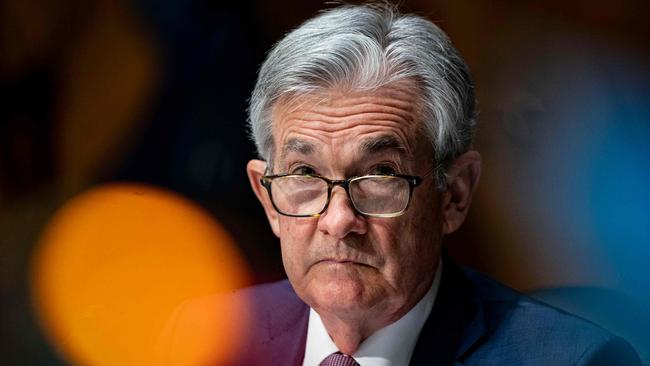Investors confident as stimulus is pared back
If shares can rally on the announcement of less stimulus from the world’s biggest central bank, cashed-up investors may just decide to ‘buy more’ shares.

If shares can rally on the formal announcement of less stimulus from the world’s biggest central bank, the conclusion among cashed-up investors may just be to “buy more” shares.
Australia’s S&P/ASX 200 index rose 0.5 per cent to a five-day high close of 7428 points, driven by record high daily closing share prices on Commonwealth Bank and Macquarie Group.
An interest rate increase from the Bank of England was possible at its meeting overnight, and there was also an OPEC+ meeting for the market to digest, but the Fed tapering announcement was one of the last big “known unknown” risks for global markets before the end of the year.
While the Australian sharemarket has bounced 4 per cent from a multi-month low of 7145.7 in September, there hasn’t been much sign that the money tidal wave of more than $40bn from dividend payments from the August reporting season, on-market share buybacks and corporate takeovers had found its way back into the sharemarket.
“The easy part is adding monetary stimulus to an economy hit by an external ‘shock’,” said CommSec chief economist Craig James. “The hard part is weaning the economy off the ‘extraordinary’ stimulus, but that is what more and more central banks are preparing to do.
“It is always uncertain how financial markets will react to decisions to pare back stimulus. But all major US sharemarket indexes rallied to finish the session at record highs, the US dollar eased modestly and US 10-year bond yields rose by five points to 1.6 per cent.
“So mission accomplished – but this is just the first baby steps of a long progress.”
Indeed, this week’s Fed meeting and confirmation of tapering may have been what the market was waiting for. There was some chance of it triggering another sell-off, but that was not the case.
The market will also start to anticipate an additional wave of money flowing to investors’ pockets from the middle of December after the October bank reporting season in Australia.
The Reserve Bank began its own “tapering” of bond buying in September. It was also able to walk away from its yield curve targeting policy this week without causing a lasting negative impact on shares. The Australian market may have some catching-up to do.
The S&P/ASX 200 was 2.8 per cent below its record high reached in August, while the S&P 500 was 2.8 per cent above its equivalent level. In price-to-earnings valuation terms, the S&P/ASX 200 was about 12 per cent below last year’s peak, while the S&P 500 was less than 8 per cent off its peak.
The bullish view assumes that economic growth – boosted by fiscal stimulus – will take over from unprecedented monetary policy stimulus to drive corporate earnings as price-to-earnings multiples cool. A policy error will be avoided in that scenario as inflation proves “transitory”, as Fed chairman Jay Powell continues to expect, albeit with less confidence than a month ago.
Global economic data has disappointed for the past few months after being surprisingly strong since mid-2020. But the Atlanta Fed’s “GDP now” forecast has taken off in the past week amid a positive run of US economic data, which continued on Thursday.
To be fair, many professionals have long predicted that “QE tapering” by the Fed would go smoothly.
That is probably one reason why Wall Street was already hitting record highs before Thursday’s announcement that the pandemic-era bond-buying program of $US120bn ($160bn) a month would be wound back by $US15bn a month until just the proceeds of its portfolio are being reinvested.
But a “taper tantrum” was still a risk and may still be if growth falters amid still high inflation.
Canaccord Genuity US equity strategist Tony Dwyer expressed some sympathy for those who felt the US sharemarket had run “too far, too fast”. After all, the S&P 500 rose 6.9 per cent in October – often a difficult month – in what has been its best month since a 10.8 per cent rise in November last year.
The S&P 500 was also up 24 per cent year to date and 113 per cent from its March 2020 low.
But while it might feel like “some kind of nasty bout of volatility” and sharemarket sell-off is overdue, Mr Dwyer says “that’s not what history shows”.
“History shows that when you’re up more than 18 per cent from January through October, you finish the year on a strong note,” he said.
“When you’ve been up more than 18 per cent … since 1950, you’ve never had a negative period from November through December, you’ve had a median gain of 6 per cent and you didn’t even have that big a drawback.”
The average drawdown was 1.6 per cent, with a maximum of 4.4 per cent, he said.
“What I find most curious is that you only have one kind of ‘blah” period of plus 1.3 per cent. Other than that, the consistency has been very high … mostly anywhere between a gain of 4 per cent and 7 per cent.”
In his view, investors should add to risk exposures on any pullback, however minor.
“Even though it feels like there should be a nasty correction because the market is up so much, the facts tell a different story,” Mr Dwyer said.





To join the conversation, please log in. Don't have an account? Register
Join the conversation, you are commenting as Logout